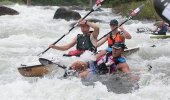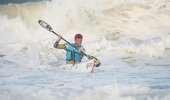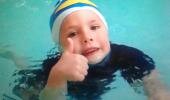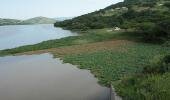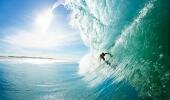Words: Deon Breytenbach ǀ Photos: Ruby & Kate Walton
It's summer and a great time to head to your nearest dam, river or lake and get in some quality paddling. Like all things in life there are risks involved with paddling, but there are precautions you can take to keep the risk factor low and fun factor high.

First up, you need some rescue gear. I've looked at personal safety gear, like helmets and PFDs in a previous article, so this time round I will have a quick look at the kit you need to help your buddy when things go south.
Basic rescue kit
You will need a basic rescue kit. My kit includes the following items: three large locking carabiners (Black Diamond RockLoc), two lengths of 1.5 m prussic cord of 5.5-6 mm diameter (Beal), a minimum of one 3 m length of tubular webbing with at least 20 kN breaking strain (Beal), Fox 40 Whistle, 15-20 m throw bag (Palm or Peak UK), and a blunt tip rescue knife (CRKT Bear Claw).
Basic first aid kit
You should also have a first aid kit. My kit contains the following basics: CPR mouthpiece, two to three pairs of latex gloves, crepe bandage, stretch plaster, gauze, Betadine, Dettol, Anthisan (for itches and stings) and eye drops. You can add things to your list if you are going out for a long day or multiple days. I usually add some meds for stomach issues, a couple of sachets of Rehydrate, Ibuprofen and some Reparil/Voltaren. With the basics, you should be able to sort out most issues or at least stablise conditions to get the victim to a professional. If you are going on a very long expedition, you will obviously need to add more items to the list, but any of the training centres mentioned below are more than willing to give you some advice and help you get what you need.
Training
I would recommend that you and your paddling buddies get some swift water rescue training. Training can be done through various centres, such as KZN Itchy Feet SA, Blyde Adventure Camp (Mpumalanga and Limpopo regions), Gravity Training (Cape region) and Whitewater Training (Gauteng and Free State regions).
Training is obviously the first choice, as it doesn’t help having all the right gear and no clue how to use it or use it safely. You can also ask some of the more experienced paddlers to show you a few of the basics while you take a lunch break on the river. The more familiar you are, the easier it becomes. Many accidents and or recues can be avoided completely by scouting properly and knowing how to identify dangerous objects or hydraulics in the river and going around them. The best rescues are the ones you avoided having to do in the first place.
At the very least, buy the book Whitewater Safety and Rescue, by Franco Ferreiro. Although it is an international book, the techniques, knots, and river hydraulic descriptions are the same no matter where you are in the world.

Procedures
Always let somebody know when you are going out for a mission and where, so that they will hopefully notice when you don’t come back and can start to make plans to look for you. If you are paddling sections that you don’t know very well, take your time scouting every rapid to make sure you don’t paddle into a river wide siphon or strainer. Never paddle further than the last safe eddy or exit point on the river bank. If you can’t see it from your kayak, then get out and scout from the bank.
Humans need oxygen, so in any situation your first priority, once you have made sure everybody else is safe, is that the victim can breathe. If you are lucky and the victim only needs a little help to get their head above water, you can give them something to push against the river bed, like a paddle, or something that floats and they can hold on to, like a kayak. Alternatively, you can use throw bags, if necessary, to make stabilisation lines for them to get support.
If the victim can breathe, you need to communicate with them to find out what the problem is and ascertain their level of consciousness. It is preferable that the victim helps themselves, but in some cases they might be so stuck that they can’t get themselves out and you will have to get a more 'hands-on' approach to save them.
Remember, the reason why 99% of us paddle is to have fun and enjoy the rivers. Keeping it safe makes it easy to keep it fun. Next year we will look at specific river hazards, how to identify them and the main rescue techniques for each situation. Until then, wear sunscreen and paddle forward.
For more information, photos and links to other online resources, visit Deon's blog: www.doitnow.co.za/blogs/deon-breytenbach
